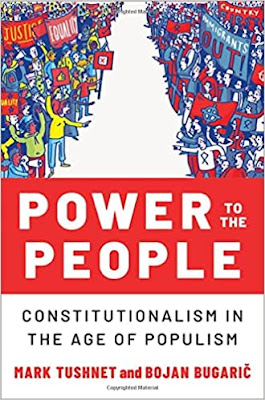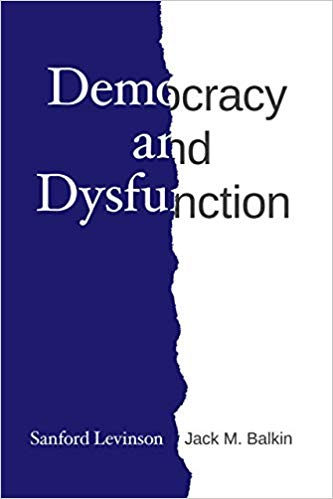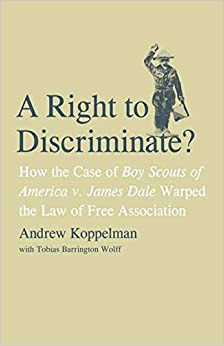Balkinization
an unanticipated consequence of
Jack M. Balkin
Balkinization Symposiums: A Continuing List
E-mail:
Jack Balkin:
jackbalkin at yahoo.com
Bruce Ackerman
bruce.ackerman at yale.edu
Ian Ayres
ian.ayres at yale.edu
Corey Brettschneider
corey_brettschneider at brown.edu
Mary Dudziak
mary.l.dudziak at emory.edu
Joey Fishkin
joey.fishkin at gmail.com
Heather Gerken heather.gerken at yale.edu
Abbe Gluck abbe.gluck at yale.edu
Mark Graber
mgraber at law.umaryland.edu
Stephen Griffin
sgriffin at tulane.edu
Jonathan Hafetz
jonathan.hafetz at shu.edu
Jeremy Kessler
jkessler at law.columbia.edu
Andrew Koppelman
akoppelman at law.northwestern.edu
Marty Lederman
msl46 at law.georgetown.edu
Sanford Levinson
slevinson at law.utexas.edu
David Luban
david.luban at gmail.com
Gerard Magliocca
gmaglioc at iupui.edu
Jason Mazzone
mazzonej at illinois.edu
Linda McClain
lmcclain at bu.edu
John Mikhail
mikhail at law.georgetown.edu
Frank Pasquale
pasquale.frank at gmail.com
Nate Persily
npersily at gmail.com
Michael Stokes Paulsen
michaelstokespaulsen at gmail.com
Deborah Pearlstein
dpearlst at yu.edu
Rick Pildes
rick.pildes at nyu.edu
David Pozen
dpozen at law.columbia.edu
Richard Primus
raprimus at umich.edu
K. Sabeel Rahmansabeel.rahman at brooklaw.edu
Alice Ristroph
alice.ristroph at shu.edu
Neil Siegel
siegel at law.duke.edu
David Super
david.super at law.georgetown.edu
Brian Tamanaha
btamanaha at wulaw.wustl.edu
Nelson Tebbe
nelson.tebbe at brooklaw.edu
Mark Tushnet
mtushnet at law.harvard.edu
Adam Winkler
winkler at ucla.edu
Compendium of posts on Hobby Lobby and related cases
The Anti-Torture Memos: Balkinization Posts on Torture, Interrogation, Detention, War Powers, and OLC
The Anti-Torture Memos (arranged by topic)
Recent Posts
What the Administration’s SNAP Freeze Teaches Us
Just A Few Blogs
ACS Blog
Alas, a Blog
Althouse
Arts and Letters Daily
Atrios (Eschaton)
Bill of Health
Buzzflash.com
Buzz Machine
Cato at Liberty
Juan Cole (Informed Comment)
Concurring Opinions
The Constitution in 2020
Corrente
Crooked Timber
Daily Howler
Daily Kos
Dana Boyd
Brad DeLong
Digby (Hullabaloo)
Discriminations
Daniel Drezner
Kevin Drum (Mother Jones)
Electrolite
En Banc
Eunomia (Daniel Larison)
Fafblog
Michael Froomkin (Discourse.net)
GovLab (Beth Noveck)
Rick Hasen (Election Law)
History News Network
How Appealing
Ignatz (Sam Heldman)
The Importance of (Ernie Miller)
Infolaw
Instapundit
International Economic Law and Policy Blog
IntLawGrrls
Jacob Levy
Jesus' General
Jurisdynamics
The Kitchen Cabinet
Mark Kleiman
Law Blog Central
Larry Lessig
Lawyers, Guns and Money
Liberal Oasis
Brian Leiter's Law School Reports
The Leiter Reports
Marginal Revolution
Megan McArdle
Memeorandum
Metafilter
Mirror of Justice
The New Republic
Newseum
No More Mister Nice Blog
Brendan Nyhan
Opinio Juris
Orcinus
The Originalism Blog
Pandagon
Passport (Foreign Policy)
Overcoming Bias
Political Animal (Washington Monthly)
Political Theory Daily Review
Political Wire (Taegan Goddard)
The Poor Man
Virginia Postrel
Prawfsblawg
Public Reason
Jonathan Rauch
Raw Story
Redstate
ReligiousLeftLaw.com
Reporters Committee For Freedom of the Press
Reproductive Rights Blog
Rothman's Roadmap to the Right of Publicity
SCOTUS Blog
Seeing the Forest
Clay Shirky
The Shifted Librarian
The Situationist
Larry Solum (Legal Theory)
Andrew Sullivan
Talking Points Memo
Talk Left
Tapped
Tbogg
TechPresident
The Paper Chase (Jurist)
Tom Paine
Tom Tomorrow (This Modern World)
Eve Tushnet
Uggabugga
University of Chicago Law School Faculty Blog
Unqualified Offerings
The Volokh Conspiracy
War and Piece (Laura Rozen)
Wampum
Oliver Willis
Wonkette
Written Description
Matthew Yglesias
Yin
Your Choice of Feeds
1. XML
powered by
2. Atom Feed
3. RSS 2.0
What the Administration’s SNAP Freeze Teaches Us
David Super
For more than a
decade, Congress has provided a contingency reserve to fund the Supplemental
Food Assistance Program (SNAP) during government shutdowns. The appropriations acts
providing them as part of an appropriation “to carry out the Food and Nutrition
Act of 2008 (7 U.S.C. 2011 et seq.),” These funds are available “in such amounts and at such times
as may become necessary to carry out program operations”. Everyone involved with SNAP, very much
including the Trump Administration, knew that for years. Several public documents from the first Trump
Administration reaffirmed this obvious point, as did the “Lapse in Funding
Plan” USDA posted
on its website on September 30 of this year.
But then there
were Democratic senators to be pressured so the Administration did a sudden
about-face, replacing its Lapse of Funding Plan with a crude attempt to blame
Democrats’ supposed allegiance to immigrants and transgender people for the
loss of SNAP funding. As discussed in my
previous post,
the Administration insisted that somehow the SNAP contingency reserve could not
be spent on SNAP benefits in a contingency.
About half the
states sued in Massachusetts while a coalition of non-profits, cities, and
retailers sued in Rhode Island and a putative nationwide class of recipients
sued in California. Those of us that
were hoping the Government’s briefs would lend some clarity about its seemingly
incoherent legal position were sorely disappointed. The Justice Department asserted that there is
“$0 in the SNAP account” notwithstanding Congress having explicitly provided $6
billion – some of which the Administration had already spent on state
administration and other things – in that account. It insisted that providing partial SNAP
benefits with the remaining balance in the contingency fund – enough to support
about two-thirds of regular benefits even if USDA did not exercise clear authority
to transfer funds from an account with a large surplus – would be worse than
providing no benefits at all. Most remarkably,
the Administration ignored the command of section
5(a) of the Food and Nutrition Act that “[a]ssistance under this program
shall be furnished to all eligible households who make application for such
participation.” It vehemently insisted that
it had discretion not to transfer funds without explaining why section 5(a) did
not curtail what discretion it might otherwise have had. In briefing and in public statements, the
Administration continued to argue that it was acting to preserve school meals
without explaining how that threat could plausibly materialize. Child nutrition programs spend about $3
billion per month. They had a reserve of
$23 billion. SNAP needed a transfer of no
more than $4.5 billion, even by the Administration’s contestable
estimates. Unless the government
shutdown lasted another half-year, child nutrition programs faced no conceivable
peril. The Administration speculated
that Congress might not provide any further funds this year for child nutrition
– something that nobody in either party has suggested and that has never
happened in the almost eighty years of these programs. Nowhere did the Administration
address last year’s 7-2 decision of
the Supreme Court that “an identified source and purpose are all that is
required for a valid appropriation”. Section
5(a) directs an activity, and section
10 of the Food and Nutrition Act specifies that benefit funds are to come
from the Treasury. Instead, the
Administration demonstrated its evolving view of the Separation of Powers when
the Solicitor General told the Supreme Court “the federal courts lack the
authority to superintend how the Executive exercises its discretionary
authority over appropriating limited funds among competing priorities.” Pity my poor students, who believe that
Congress appropriates
federal funds. Not surprisingly, the
Rhode Island and Massachusetts courts quickly rejected the Administration’s
claim that it could not spend the SNAP contingency reserve on SNAP. Each in its own way tried to give the
Administration room to make its own decision that this was precisely the
situation where the transfer authority needed to be exercised. The Rhode Island court gave the Administration
until Wednesday to issue reduced benefits if that was its preference. The Administration
finally abandoned its argument about the contingency fund but refused to
transfer funds and instead demanded that states follow a complicated process to
recalculate benefits for every household to receive partial benefits. USDA’s own declaration conceded that this
could take weeks or months for some states to accomplish due to antiquated
automated systems. As if this
obstacle was not enough, USDA then released erroneous tables to guide state
recalculations. These tables would cut
benefits far more than was necessary to stay within the contingency fund. The calculations required are relatively simple,
and plaintiffs submitted a declaration showing USDA’s error. USDA then responded with correct tables,
insisting that it was planning to do this all the time. With 42 million
people lacking food assistance, the Rhode Island court last Thursday became exasperated
with USDA’s foot-dragging and issued an order enforcing its earlier temporary
restraining order (TRO) to compel USDA to issue full November benefits. It also adjudicated the transfer authority
question and found that section 5(a) compelled USDA to provide full
funding. USDA issued
guidance Friday afternoon saying that it was “working towards implementing
November 2025 full benefit issuances” and promising “[l]ater today, FNS will
complete the processes necessary to make funds available to support your
subsequent transmittal of full issuance files to your EBT processor.” The guidance made no mention of the
possibility that USDA might reverse its position if it obtained a stay of the
Rhode Island court’s orders. In response,
numerous states – predominately blue but including a smattering of red – issued
full SNAP benefits for November. Friday evening,
the First Circuit denied the Administration’s request for an administrative
stay of the Rhode Island court’s orders but indicated it was still working on
the Administration’s request for a stay pending appeal. The Administration went to the Supreme Court,
and Justice Jackson entered an administrative stay to last until 48 hours after
the First Circuit resolved the Administration’s request for a stay pending
appeal. She offered little explanation,
but one may speculate that, with a very thin opinion from the district court
and none of substance from the First Circuit, she may have felt the case was
not sufficiently presented for the full Court to consider the merits of a stay
pending appeal. For roughly a full
day after Justice Jackson entered her stay, USDA left its Friday “full benefit
issuances” guidance in place. Some additional
states initiated or completed issuances during this time. Saturday night, however, USDA posted new
guidance to its website forbidding full issuances, demanding that states “undo”
issuances they already had completed – which would violate USDA’s own
regulations – and threatening dire penalties against the states that had issued
in response to its prior guidance. Late Sunday night,
the First Circuit unanimously rejected the Administration’s petition for a stay
pending appeal. It found that the Administration
had not meaningfully countered the district court’s finding that its foot-dragging,
and the prospect of weeks of further delay, violated its initial TRO – which the
Administration had not sought to have modified or timely told any court was
unachievable. The First Circuit found
that, and the equities in favor of 42 million hungry people, militated in favor
of letting the district court’s enforcement order stand. By then, Congress
was already moving toward ending the shutdown.
When Justice Jackson’s administrative stay was about to expire last
night, the full Supreme Court, over her dissent, extended the administrative
stay two more days. Meanwhile, the
states sought and received a TRO from the Massachusetts district court preventing
USDA from following through on the threats in its Saturday evening memo or compelling
those states to try to retrieve the benefits illegally. Nonetheless, USDA has threatened EBT
contractors in the states that issued benefits Friday and Saturday with not
being reimbursed for benefits spent in those states. This would effectively shut down SNAP in
those states for all benefits, including remaining balances from earlier
months. USDA stated that, to remove this
obstruction, all states had to do was retrieve the benefits USDA no longer
believed were properly issued. USDA’s
brief describes a weird quasi-block grant it seems to have imposed on SNAP
without any authority in statute or regulation.
Apparently at least one state complied.
With the shutdown ending, it is unclear what if any consequences USDA
will face for its blatant disregard of the Massachusetts court’s order. This entire
episode is tragic. We likely will see
waves of evictions and utility shutoffs in the months to come against households
forced to divert what cash they had to purchasing food. When SNAP benefits are restored, some
households may illegally try to sell them for cash – at a huge loss – to scrape
together the funds needed to stave off these evictions and utility
shutoffs. Myriad other difficult
personal decisions, including some with likely tragic consequences, will flow
from this entirely unnecessary crisis and the Administration’s crude
exploitation of vulnerable Americans for political gains. The episode also
has much to teach us about the state of our government. The Administration’s initial position, in its
September 30 “Lapse in Funding Plan”, was legally correct and consistent with
what prior administrations, including the first Trump Administration, had
always said. But no meaningful
guardrails prevented it from switching off that position to a series of
ludicrous arguments, which the Justice Department had no problem pressing in
court. The Administration has gutted the
experienced, highly professional staff that had run SNAP effectively for
decades, and the remnants were incapable of performing simple benefit calculations,
of following simple regulations, of writing competent guidance to states, or of
recognizing the need to timely replace that guidance when its policy
changed. And neither the agency nor the
Justice Department was especially concerned about violating multiple court
orders. Those believing
that the key to understanding governance in our time is careful attention to
the President’s social media posts were surely disappointed: on November 1 he posted that it would be his
honor to issue SNAP if a court told him from what source of money they should
be drawn but then later in the week attacked the program as serving the
unworthy and insisted that the Government should stay liquid, presumably by
withholding funds for SNAP benefits. Most remarkably,
the Solicitor General declares in a brief to the Supreme Court what has become
increasingly evident this year: the
Trump Administration is done with the Appropriations Clause and is claiming the
Power of the Purse for itself. I will
shortly post on the sad fate of that Clause more generally. The response of
ordinary people around the country to the Administration’s cut-off of SNAP has
been heartening. It confirms a trend we
have seen in other venues, such as responses to federal law enforcement
officers’ abuses: We the People currently
have a much clearer vision of this country’s core values than does institutional
America. Those of us invested in
gesellschaft need to lose our arrogance and recognize everything that gemeinschaft
gets right. But the capacity of local volunteers
of good will is woefully insufficient to offset the devastation wrought by a
federal government that increasingly considers itself above the law. @DavidASuper1
@DavidASuper.bsky.social
Posted
9:39 AM
by David Super [link]
Books by Balkinization Bloggers

Linda C. McClain and Aziza Ahmed, The Routledge Companion to Gender and COVID-19 (Routledge, 2024)

David Pozen, The Constitution of the War on Drugs (Oxford University Press, 2024)

Jack M. Balkin, Memory and Authority: The Uses of History in Constitutional Interpretation (Yale University Press, 2024)

Mark A. Graber, Punish Treason, Reward Loyalty: The Forgotten Goals of Constitutional Reform after the Civil War (University of Kansas Press, 2023)

Jack M. Balkin, What Roe v. Wade Should Have Said: The Nation's Top Legal Experts Rewrite America's Most Controversial Decision - Revised Edition (NYU Press, 2023)

Andrew Koppelman, Burning Down the House: How Libertarian Philosophy Was Corrupted by Delusion and Greed (St. Martin’s Press, 2022)

Gerard N. Magliocca, Washington's Heir: The Life of Justice Bushrod Washington (Oxford University Press, 2022)

Joseph Fishkin and William E. Forbath, The Anti-Oligarchy Constitution: Reconstructing the Economic Foundations of American Democracy (Harvard University Press, 2022)

Mark Tushnet and Bojan Bugaric, Power to the People: Constitutionalism in the Age of Populism (Oxford University Press 2021).

Mark Philip Bradley and Mary L. Dudziak, eds., Making the Forever War: Marilyn B. Young on the Culture and Politics of American Militarism Culture and Politics in the Cold War and Beyond (University of Massachusetts Press, 2021).

Jack M. Balkin, What Obergefell v. Hodges Should Have Said: The Nation's Top Legal Experts Rewrite America's Same-Sex Marriage Decision (Yale University Press, 2020)

Frank Pasquale, New Laws of Robotics: Defending Human Expertise in the Age of AI (Belknap Press, 2020)

Jack M. Balkin, The Cycles of Constitutional Time (Oxford University Press, 2020)

Mark Tushnet, Taking Back the Constitution: Activist Judges and the Next Age of American Law (Yale University Press 2020).

Andrew Koppelman, Gay Rights vs. Religious Liberty?: The Unnecessary Conflict (Oxford University Press, 2020)

Ezekiel J Emanuel and Abbe R. Gluck, The Trillion Dollar Revolution: How the Affordable Care Act Transformed Politics, Law, and Health Care in America (PublicAffairs, 2020)

Linda C. McClain, Who's the Bigot?: Learning from Conflicts over Marriage and Civil Rights Law (Oxford University Press, 2020)

Sanford Levinson and Jack M. Balkin, Democracy and Dysfunction (University of Chicago Press, 2019)

Sanford Levinson, Written in Stone: Public Monuments in Changing Societies (Duke University Press 2018)

Mark A. Graber, Sanford Levinson, and Mark Tushnet, eds., Constitutional Democracy in Crisis? (Oxford University Press 2018)

Gerard Magliocca, The Heart of the Constitution: How the Bill of Rights became the Bill of Rights (Oxford University Press, 2018)

Cynthia Levinson and Sanford Levinson, Fault Lines in the Constitution: The Framers, Their Fights, and the Flaws that Affect Us Today (Peachtree Publishers, 2017)

Brian Z. Tamanaha, A Realistic Theory of Law (Cambridge University Press 2017)

Sanford Levinson, Nullification and Secession in Modern Constitutional Thought (University Press of Kansas 2016)

Sanford Levinson, An Argument Open to All: Reading The Federalist in the 21st Century (Yale University Press 2015)

Stephen M. Griffin, Broken Trust: Dysfunctional Government and Constitutional Reform (University Press of Kansas, 2015)

Frank Pasquale, The Black Box Society: The Secret Algorithms That Control Money and Information (Harvard University Press, 2015)

Bruce Ackerman, We the People, Volume 3: The Civil Rights Revolution (Harvard University Press, 2014)
Balkinization Symposium on We the People, Volume 3: The Civil Rights Revolution

Joseph Fishkin, Bottlenecks: A New Theory of Equal Opportunity (Oxford University Press, 2014)

Mark A. Graber, A New Introduction to American Constitutionalism (Oxford University Press, 2013)

John Mikhail, Elements of Moral Cognition: Rawls' Linguistic Analogy and the Cognitive Science of Moral and Legal Judgment (Cambridge University Press, 2013)

Gerard N. Magliocca, American Founding Son: John Bingham and the Invention of the Fourteenth Amendment (New York University Press, 2013)

Stephen M. Griffin, Long Wars and the Constitution (Harvard University Press, 2013)

Andrew Koppelman, The Tough Luck Constitution and the Assault on Health Care Reform (Oxford University Press, 2013)

James E. Fleming and Linda C. McClain, Ordered Liberty: Rights, Responsibilities, and Virtues (Harvard University Press, 2013)
Balkinization Symposium on Ordered Liberty: Rights, Responsibilities, and Virtues

Andrew Koppelman, Defending American Religious Neutrality (Harvard University Press, 2013)

Brian Z. Tamanaha, Failing Law Schools (University of Chicago Press, 2012)

Sanford Levinson, Framed: America's 51 Constitutions and the Crisis of Governance (Oxford University Press, 2012)

Linda C. McClain and Joanna L. Grossman, Gender Equality: Dimensions of Women's Equal Citizenship (Cambridge University Press, 2012)

Mary Dudziak, War Time: An Idea, Its History, Its Consequences (Oxford University Press, 2012)

Jack M. Balkin, Living Originalism (Harvard University Press, 2011)

Jason Mazzone, Copyfraud and Other Abuses of Intellectual Property Law (Stanford University Press, 2011)

Richard W. Garnett and Andrew Koppelman, First Amendment Stories, (Foundation Press 2011)

Jack M. Balkin, Constitutional Redemption: Political Faith in an Unjust World (Harvard University Press, 2011)

Gerard Magliocca, The Tragedy of William Jennings Bryan: Constitutional Law and the Politics of Backlash (Yale University Press, 2011)

Bernard Harcourt, The Illusion of Free Markets: Punishment and the Myth of Natural Order (Harvard University Press, 2010)

Bruce Ackerman, The Decline and Fall of the American Republic (Harvard University Press, 2010)
Balkinization Symposium on The Decline and Fall of the American Republic

Ian Ayres. Carrots and Sticks: Unlock the Power of Incentives to Get Things Done (Bantam Books, 2010)

Mark Tushnet, Why the Constitution Matters (Yale University Press 2010)
Ian Ayres and Barry Nalebuff: Lifecycle Investing: A New, Safe, and Audacious Way to Improve the Performance of Your Retirement Portfolio (Basic Books, 2010)
.jpg)
Jack M. Balkin, The Laws of Change: I Ching and the Philosophy of Life (2d Edition, Sybil Creek Press 2009)

Brian Z. Tamanaha, Beyond the Formalist-Realist Divide: The Role of Politics in Judging (Princeton University Press 2009)

Andrew Koppelman and Tobias Barrington Wolff, A Right to Discriminate?: How the Case of Boy Scouts of America v. James Dale Warped the Law of Free Association (Yale University Press 2009)

Jack M. Balkin and Reva B. Siegel, The Constitution in 2020 (Oxford University Press 2009)
Heather K. Gerken, The Democracy Index: Why Our Election System Is Failing and How to Fix It (Princeton University Press 2009)

Mary Dudziak, Exporting American Dreams: Thurgood Marshall's African Journey (Oxford University Press 2008)

David Luban, Legal Ethics and Human Dignity (Cambridge Univ. Press 2007)

Ian Ayres, Super Crunchers: Why Thinking-By-Numbers is the New Way to be Smart (Bantam 2007)

Jack M. Balkin, James Grimmelmann, Eddan Katz, Nimrod Kozlovski, Shlomit Wagman and Tal Zarsky, eds., Cybercrime: Digital Cops in a Networked Environment (N.Y.U. Press 2007)

Jack M. Balkin and Beth Simone Noveck, The State of Play: Law, Games, and Virtual Worlds (N.Y.U. Press 2006)

Andrew Koppelman, Same Sex, Different States: When Same-Sex Marriages Cross State Lines (Yale University Press 2006)
Brian Tamanaha, Law as a Means to an End (Cambridge University Press 2006)
Sanford Levinson, Our Undemocratic Constitution (Oxford University Press 2006)
Mark Graber, Dred Scott and the Problem of Constitutional Evil (Cambridge University Press 2006)
Jack M. Balkin, ed., What Roe v. Wade Should Have Said (N.Y.U. Press 2005)
Sanford Levinson, ed., Torture: A Collection (Oxford University Press 2004)
Balkin.com homepage
Bibliography
Conlaw.net
Cultural Software
Writings
Opeds
The Information Society Project
BrownvBoard.com
Useful Links
Syllabi and Exams